Dr Laura Currie

Contact details
Department of Mathematical Sciences
Durham University
Upper Mountjoy Campus
Durham, UK
DH1 3LE
office: MCS 3102
tel: 0191 334 0860
email: laura.currie “at” durham.ac.uk
Currently, I am an Assistant Professor in the Applied and Computational Mathematics group based in the Department of Mathematical Sciences at Durham University. Prior to that, I spent time as a Research Fellow at the University of Exeter in both the Astrophysics group in Physics and the Centre for Geophysical and Astrophysical Fluids group in Mathematics. I obtained my PhD in Applied Mathematics under the supervision of Prof. Steve Tobias at the University of Leeds.
Current Opportunities
If you are a prospective PhD student, please get in touch with me at the email address above. More about about my research interests (and some potential PhD projects) can be found below.
Research Interests
My research interests lie in the mathematical modelling of problems in fluid dynamics and MHD often motivated by those problems with applications to astrophysical contexts. I am interested in the interaction of convection with rotation, magnetic field and stratification, and the implication of these interactions for stellar and planetary interiors. Some key issues that interest me include understanding how large-scale flows are driven, how large-scale magnetic fields (like the ones observed in many astrophysical bodies) are generated through dynamo action and also how convective heat transport is influenced by rotation and magnetic field. See below for examples of projects I have worked on.
Potential PhD projects
Some potential PhD projects are listed below. I am also open to developing projects aligned with my research interests from ideas that prospective students may have. Most of the projects will involve developing and/or using numerical simulations so prior coding experience would be beneficial but is not essential. If you would like to discuss anything further, please send me an email.
The effects of large-scale flows on convective heat transport. Convection is known to generate large-scale flows which can act back on the convection and modify the heat transport properties. This project would aim to quantify these effects and develop a theory for the inclusion of these effects in models of stellar and planetary interiors.
Magnetic field generation in the presence of shear flows. Shear flows are expected to play an important role in the generation of large-scale magnetic fields by dynamo action. This project would examine the effect of different shear flows on the type of magnetic field generated and would aim to determine which type of convective flows (which are capable of self-consistently generating a shear flow) are candidates for generating large-scale magnetic field.
The effect of ohmic heating in strongly stratified magnetoconvection. Convection in a star or planet must be maintained against dissipation. In strongly stratified fluids influenced by magnetism, this dissipation is expected to be large and dominated by Ohmic heating effects from currents. This project would compare theoretical results with those realised in numerical models of a convection zone and determine if information about the dissipation can provide important constraints on flows and fields in stellar or planetary interiors.
Convection influenced by rotation: simulations and theory
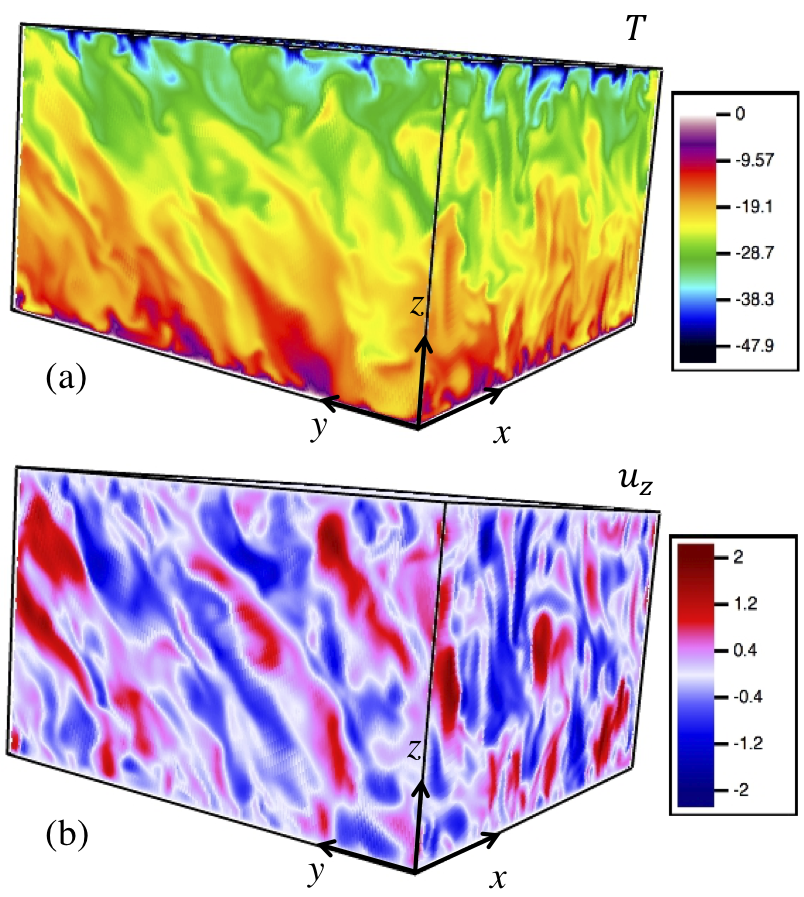
All stars, and many planets, carry energy by convection in some parts of their interiors. The heat transport associated with this convection, which must be calculated in order to construct a consistent stellar or planetary structure model, is influenced by rotation or magnetism. But a quantitative understanding of the effects these have on the convection, and so ultimately on stellar/planetary evolution, is still lacking. A central problem is that the convective dynamics occur on timescales that are much shorter than the evolutionary ones. Hence, numerical simulations that can adequately resolve the convective flows cannot be evolved over evolutionary timescales in order to investigate long-term effects on stellar structure.
In this work we conducted a large survey of 3D simulations in localised, Cartesian domains tilted at some angle with respect to the rotation vector. These box simulations served as idealised representations of a small part of a rotating star or planet, situated at various latitudes. We used these to analyse the rich variety of phenomena that occur as the rotation rate and latitude are changed, and to compute how the temperature gradient established by the convection varies with these parameters. Broadly, rotation makes the heat transport less efficient, leading to steeper temperature gradients. We compared the results of these calculations to expectations from semi-analytical theory: in particular, we showed that a new multi-mode “rotating mixing length” theory (based on earlier work by Stevenson 1979) provides a reasonably good description of the dynamics at most latitudes and rotation rates. This semi-analytical model could be incorporated into 1D stellar evolution codes.
Figure: Example snapshot of temperature and vertical flows from a rotating 3D simulation at a latitude of 45°. The convective plumes tend to align with the rotation axis. [Currie et al. 2020].
Viscous dissipation in stratified convection
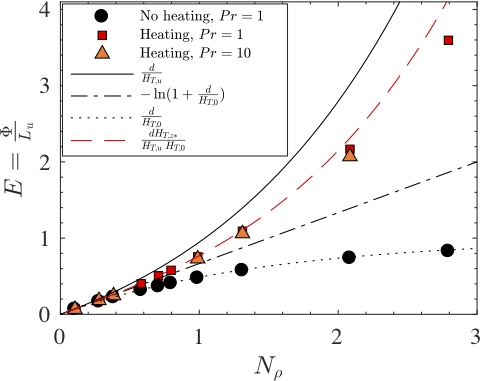
Convection in astrophysical systems must be maintained against dissipation. Although the effects of dissipation are often assumed to be negligible, theory suggests that in strongly stratified convecting fluids, the dissipative heating rate can exceed the luminosity carried by convection. In this work we explored this possibility using a series of numerical simulations. We considered two-dimensional numerical models of hydrodynamic convection in a Cartesian layer under the anelastic approximation and demonstrate that the dissipative heating rate can indeed exceed the imposed luminosity. We established a theoretical expression for the ratio of the dissipative heating rate to the luminosity emerging at the upper boundary, in terms only of the depth of the layer and the thermal scale height. In particular, we showed that this ratio is independent of the diffusivities and confirm this with a series of numerical simulations. Our results suggest that dissipative heating may significantly alter the internal dynamics of stars and planets. Work is ongoing to investigate if the results explored here also apply to the full 3D problem with rotation and magnetism. If this turns out to be the case then the total dissipative heating is determined non-locally, dependent as it is on the total layer depth. Simple modifications to the mixing-length theory (which is determined locally) may not then suffice to capture it.
Figure: Global dissipative heating rate normalized by the luminosity, \(E\), against \(N_\rho\) for \(Pr=1\) (red squares) and \(Pr=10\) (orange triangles). Cases in which the dissipative heating terms were not included in the energy equation are denoted by black circles. See Currie & Browning (2017) for more details.
Mean flows and vortices in anelastic convection
From the jets and vortices on Jupiter to the winds in stars, systematic astrophysical flows can be generated by the interaction of convection with rotation and stratification. Here, we investigated this complicated interplay in detail. In particular, we considered the effect of stratification on systematic large-scale flows generated in anelastic convection. We presented results from three-dimensional numerical simulations of convection in a rotating plane layer in which the angle between the axis of rotation and gravity was allowed to vary. We considered two distinct parameter regimes: (i) weakly rotating and (ii) rapidly rotating. In each case, we examined the effect of stratification on the flow structure and heat transport properties focusing on the difference between Boussinesq and anelastic convection. Furthermore, we showed that regimes (i) and (ii) generate very different large-scale flows and investigated the role stratification has in modifying these flows. The stratified flows possess a net helicity not present in the Boussinesq cases which we suggest, when combined with the self-generated shear flows, could be important for dynamo action.
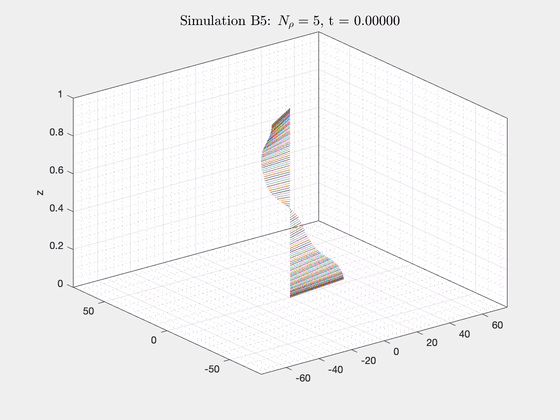
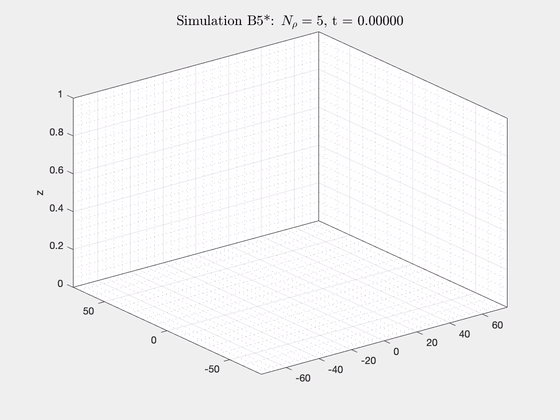
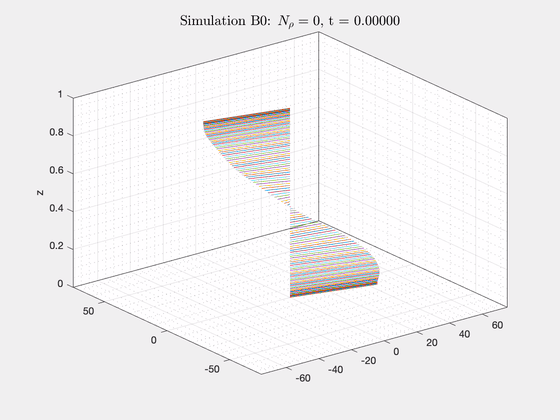
Publications
Currie, L. K., & Jones, C. A., Model of deep zonal flows in giant planets, Monthly Physical Review Fluids, 10, 10 (2025) [publisher’s site]
Joshi-Hartley, T., Browning, M. K., Currie, L. K., Lewis, N. T., Brown, B. P., & Lance, S.R., Heat transport and dissipation in 2.5 D rotating internally heated and cooled convection, Monthly Notices of the Royal Astronomical Society, 542, 3 (2025) [publisher’s site]
Lance, S. R., Currie, L. K., & Browning, M. K., Viscous dissipation and dynamics in simulations of rotating, stratified plane-layer convection, Monthly Notices of the Royal Astronomical Society, 528, 4 (2024) [publisher’s site]
Currie, L. K., & Tobias, S. M., Generation of shear flows and vortices in rotating anelastic convection, Physical Review Fluids, 5, 073501 (2020) [publisher’s site]
Currie, L. K., Barker, A. J., Lithwick, Y., & Browning, M. K., Convection with misaligned gravity and rotation: simulations and rotating mixing length theory, Monthly Notices of the Royal Astronomical Society, 493, 4 (2020) [publisher’s site]
Currie, L. K., & Tobias, S. M., Convection-driven kinematic dynamos with a self-consistent shear flow, Geophysical & Astrophysical Fluid Dynamics, 113, 131 (2019) [publisher’s site]
Currie, L. K., & Browning, M. K., The magnitude of viscous dissipation in strongly stratified two-dimensional convection, The Astrophysical Journal Letters, 845, L17, (2017) [publisher’s site]
Currie, L. K., The effect of magnetic field on mean flow generation by rotating two-dimensional convection, The Astrophysical Journal, 832(1), 14 (2016) [publisher’s site]
Currie, L. K., & Tobias, S. M., Mean flow generation in rotating anelastic two-dimensional convection, Physics of Fluids, 28, 017101 (2016) [publisher’s site]
Talks
Selected seminar & conference presentations
Rotating and stratified convection: mixing length theory and simulations,Fluid flow and magnetic dynamos: From the laboratory to the stars and planets, Sept. 2025, Ascona.
Viscous dissipation and heat transport in stratified convection: theory and simulations, Research Institute for Mathematical Sciences Seminar, Aug. 2025, Kyoto University.
Towards a diffusion-free regime in models of stellar and planetary convection: theory and simulations, NIFS Seminar, July 2025, National Institute for Fusion Science, Japan.
What Lies Beneath: The fluid dynamics of stellar and planetary interiors, CDT Fluid Dynamics Symposum, June 2025, Leeds.
Helicity production and transfer in rotating convection (interactive poster), Division of Fluid Dynamics Meeting, Nov. 2024, Salt Lake City.
Deep zonal flows in giant planets, Geophysical and Astrophysical Fluids Seminar, Nov. 2024, CU, Boulder.
Deep zonal flows in giant planets, Geophysical and Astrophysical Fluids and Dynamos Meeting, Sept. 2024, Leeds.
Helicity production and transfer in rotating convection, Durham-Dundee MHD Day, May 2024, Durham.
Rotation, magentism and stratification in models of stellar convection, Mathematics Research Seminar, May 2024, University of Dundee.
Rotation, magentism and stratification in models of stellar convection, Centre for Fusion Space and Astrophysics Seminar, March 2024, University of Warwick.
Viscous dissipation in stratified convection, Geophysical and astrophyscial fluid dynamics in experiments and models meeting, Sept. 2023, Nice.
Rotation, magentism and stratification in models of stellar convection, UKMHD meeting, May 2023, University of Leeds.
Multi-scale processes in astrophysical fluid dynamics, Department of Mathematical Sciences Research Colloquium, May 2023, Durham.
Modelling stellar interiors, Computer models, simulations, data and reality meeting, May 2023, IAS/IDAS, Durham.
The dynamics of stars and planets, Retreat for Women in Applied Mathematics, Jan. 2023, ICMS, Edinburgh.
Viscous dissipation in simulations of stratified rotating convection (poster, first author Simon Lance) and An investigation into convectively driven shear at low Prandtl number (poster, first author Tom Joshi-Cale), Cool stars meeting, July 2022, Toulouse.
Large-scale flows and magnetic fields in fluid dynamics, Physics lunchtime seminar series, May 2022, Durham.
How does the Sun generate its magnetic field? Applied Mathematics seminar, May 2022, Durham.
Stratification effects in convecting systems, Durham-Dundee MHD Day, April 2022, Durham.
Large-scale flows and magnetic fields in fluid dynamics, Durham Maths Research Day, Sept. 2021, Durham (virtual).
The role of waves in the creation of low frequency dynamics in fluids, Applied Mathematics seminar, July 2021, Durham (virtual).
The role of waves in the creation of low frequency dynamics in fluids, Fluids & MHD Seminar, May 2021, University of Leeds (virtual).
Stratification effects in anelastic convection, Compressible Convection Conference, Sept. 2019, Newcastle.
The magnitude of viscous dissipation in strongly stratified two-dimensional convection, Stellar Hydro Days conference, June 2019, University of Exeter.
Modelling heat transport and magnetism in stellar convection zones, Applied Mathematics seminar, Mar. 2019, University of Glasgow.
Validity of rotating mixing length theory in convective layers with oblique rotation, Rotating convection: from the lab to the stars workshop, May. 2018, Leiden.
Extending mixing length theory: the effect of dissipation and rotation on convection, Astrophysics seminar, Dec. 2017, Queen Mary University of London.
The magnitude of viscous dissipation in strongly stratified two-dimensional convection, Compressible Convection Conference, Sept. 2017, Lyon.
Convective dynamos with self-consistent shear, Natural Dynamos meeting, June 2017, Valtice.
Dissipation, rotation and other missing ingredients in mixing length theory, Astrophysics seminar, Mar. 2017, DAMTP, University of Cambridge.
Rotation, dissipation, and other missing ingredients in mixing length theory, Applied Mathematics seminar, Nov. 2016, University of Newcastle.
Scaling laws in rotating turbulent convection (poster), Astro Fluid meeting in honour of Jean-Paul Zahn, June 2016, Paris.
Scaling laws in rotating convection (poster) and Investigating the effects of rotation on stellar radii in 1D stellar structure models, (poster, first author Lewis G.Ireland), Cool stars meeting, June 2016, Uppsala.
Dissipation in convective flows, UKMHD meeting, May 2016, University of Glasgow.
Scaling laws in rotating convection, Stellar and Planetary Dynamos meeting, May 2015, University of Goettingen.
2D models of convection-driven mean flows, Astrophysics seminar, Oct. 2014, University of Exeter.
Mean flow generation in rotating two-dimensional magnetoconvection, European MHD days meeting, Sept. 2014, University of Cambridge.
Mean flow generation in rotating 2d convection (poster), Eddy – Mean-Flow Interactions in Fluids conference, Mar. 2014, KITP, Santa Barbara.
The driving of mean flows via convection, Rotating fluid dynamics for planetary and stellar applications workshop, May 2013, University of Exeter.
Convection driven mean flows (poster), British Applied Mathematics Colloquium, Apr. 2013, University of Leeds.
The driving of mean flows via convection, Fluids and MHD seminar, Nov. 2012, University of Leeds.
Convection driven mean flows (poster), European MHD days meeting, Oct. 2012, Nice.
The effect of a tilted rotation vector on the convective driving of mean flows, UKMHD meeting, May 2012, University of Sheffield.
Teaching
2025-26
- Maths for Engineers and Scientists (Michaelmas) [Ultra page]
- Geophysical and Astrophysical Fluids IV (Epiphany)
[Ultra
page]
- Project III [topic: Dynamo Theory]
2024-25
- Geophysical and Astrophysical Fluids IV (Epiphany)
[Ultra
page]
- Project III [topic: Modelling the magnetic fields of the Sun and other stars]
2023-24
- Maths for Engineers and Scientists (Michaelmas) [Ultra page]
- Geophysical and Astrophysical Fluids IV (Epiphany)
[Ultra
page]
- Project III [topic: Spectral Methods]
2022-23
- Maths for Engineers and Scientists (Michaelmas) [Ultra page]
- Calculus I tutorials (Epiphany)
[Ultra
page]
- Dynamics I tutorials (Epiphany)
[Ultra
page]
- Project IV [topic: Hydrodynamic Instabilities]
2021-22
- Numerical Analysis II tutorials (Michaelmas)
[Ultra
page]
- Calculus I tutorials
[Ultra
page]
- Continuous Systems, MiSCaDA (Epiphany)
[Ultra
page]
- Project III [topic: Convection in stars and planets]